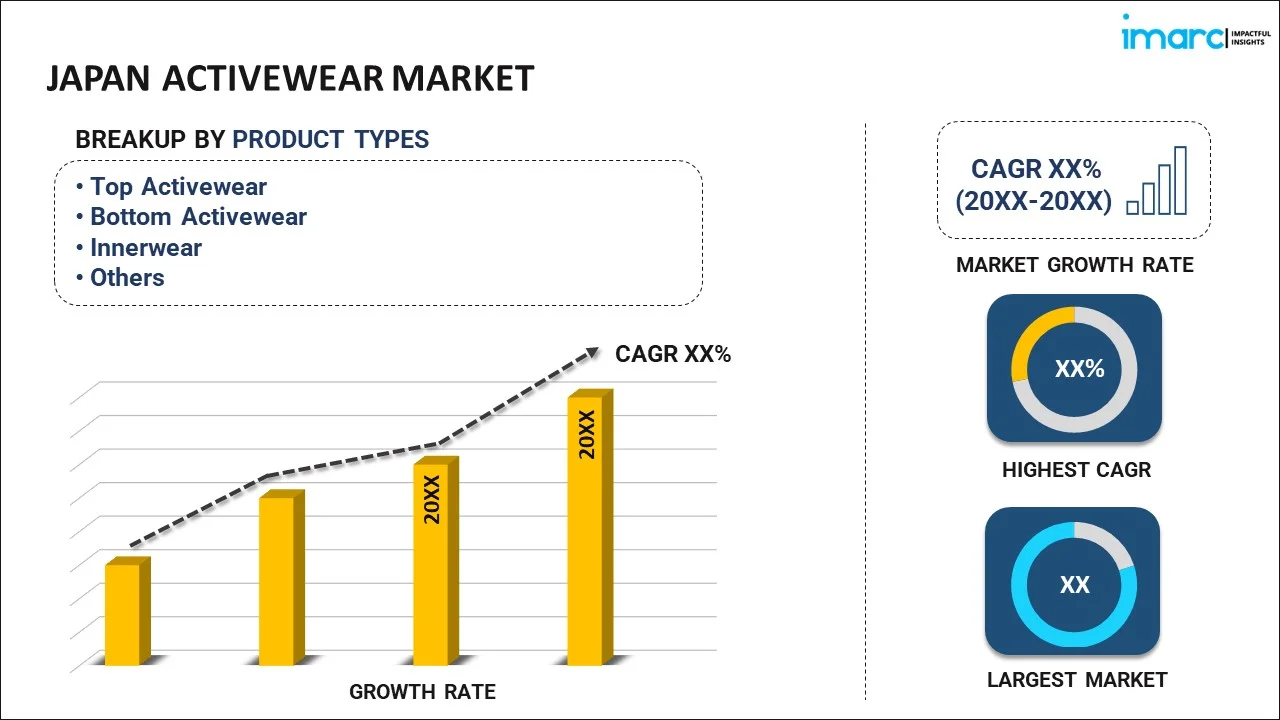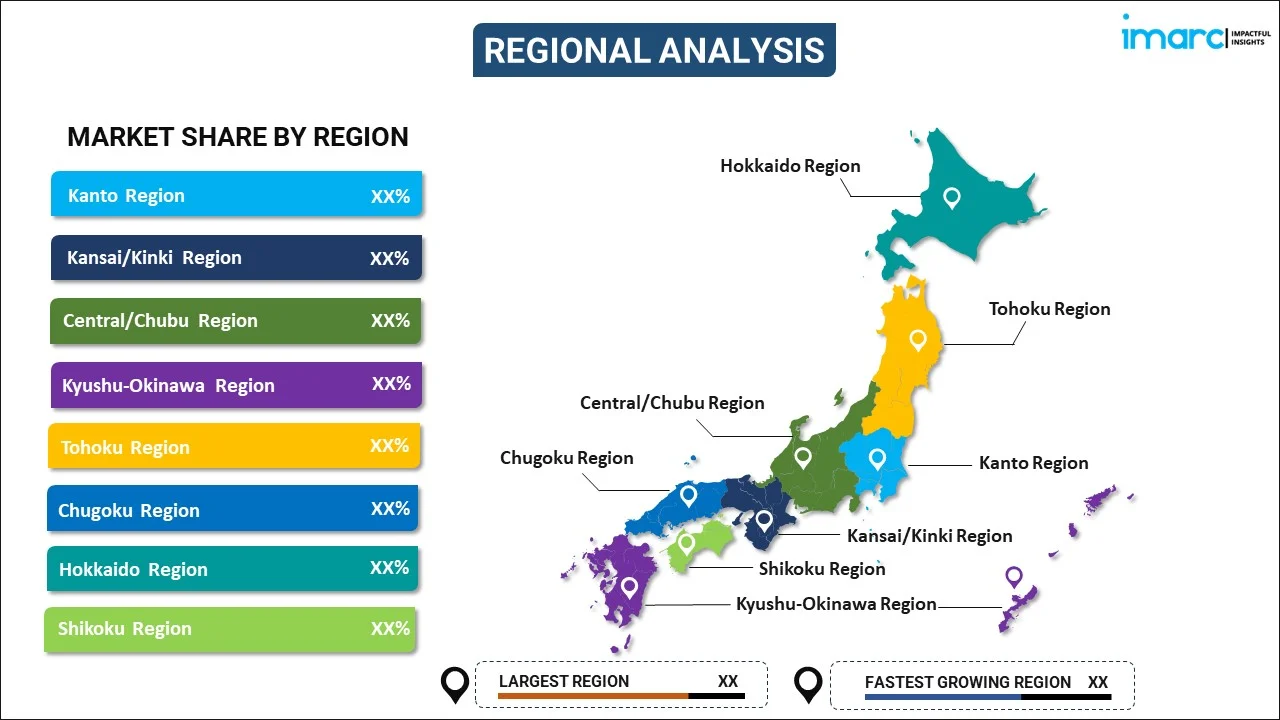
Japan Activewear Market Report by Product Type (Top Activewear, Bottom Activewear, Innerwear, Swimwear, Outerwear), Material Type (Nylon, Polyester, Cotton, Neoprene, Polypropylene, Spandex), Pricing (Economy, Premium), Age Group (1 – 15 Years, 16 – 30 Years, 31 – 44 Years, 45 – 64 Years, More than 65 Years), Distribution Channel (Online Stores, Offline Stores), End User (Men, Women, Kids), and Region 2025-2033
Market Overview:
Japan activewear market size reached USD 18.6 Billion in 2024. Looking forward, IMARC Group expects the market to reach USD 33.4 Billion by 2033, exhibiting a growth rate (CAGR) of 6.2% during 2025-2033. The increasing health and fitness awareness, rising trend of fashion and style statement, rapid e-commerce growth, growing sustainability concerns that has encouraged the adoption of eco-friendly activewear options, advancements in innovation and technology, and stable economic conditions represent some of the key factors driving the market.
|
Report Attribute
|
Key Statistics
|
|---|---|
|
Base Year
|
2024 |
|
Forecast Years
|
2025-2033
|
|
Historical Years
|
2019-2024
|
| Market Size in 2024 | USD 18.6 Billion |
| Market Forecast in 2033 | USD 33.4 Billion |
| Market Growth Rate (2025-2033) | 6.2% |
Activewear is a category of clothing designed for physical activity and exercise. It encompasses a wide range of garments and accessories tailored to support and enhance various forms of workouts and athletic pursuits. Typically, activewear includes items like workout leggings, sports bras, moisture-wicking T-shirts, running shorts, and athletic shoes. These pieces are carefully crafted with materials that offer comfort, breathability, and flexibility, ensuring that individuals can move freely during their fitness routines. One of the key features of activewear is its ability to manage moisture and temperature. Many activewear fabrics are designed to wick away sweat, helping to keep the wearer dry and comfortable during intense workouts. Additionally, activewear often incorporates elements such as compression technology to support muscles, reflective detailing for safety during low-light activities, and ergonomic designs that reduce friction and chafing.
Japan Activewear Market Trends:
The increasing awareness about the importance of a healthy lifestyle and regular exercise has been a significant factor driving the market in Japan. With a growing emphasis on well-being, more individuals are adopting active routines, leading to a higher demand for activewear. Additionally, the aging population in Japan has led to a greater focus on health and fitness, with many seniors engaging in activities like yoga and swimming. This demographic shift has created a market for activewear that caters to older adults, emphasizing comfort and functionality. Other than this, activewear is no longer solely associated with sports as it has become a fashion statement. Japanese consumers are increasingly seeking stylish activewear that can seamlessly transition from the gym to casual wear, driving the demand for athleisure apparel. Besides this, the rise of e-commerce platforms has made activewear more accessible to consumers across Japan. Online shopping offers a wide variety of options, allowing shoppers to explore different brands and styles, contributing to market growth. In line with this, sustainability concerns are gaining prominence in Japan, and this extends to activewear. Consumers are looking for eco-friendly activewear options made from sustainable materials, contributing to the growth of this niche segment. Furthermore, the popularity of specific fitness trends, such as yoga, Pilates, and CrossFit, has encouraged individuals to opt for specialized activewear designed to cater to the unique requirements of these activities. Apart from these factors, hosting major sporting events like the Olympics and international competitions can boost the activewear market. Such events create excitement around sports and fitness, encouraging individuals to invest in quality activewear. Moreover, economic stability and disposable income levels play a role in the activewear market. As the Japanese economy continues to recover, consumers may be more inclined to invest in higher-end activewear products.
Japan Activewear Market Segmentation:
IMARC Group provides an analysis of the key trends in each segment of the market, along with forecasts at the country level for 2025-2033. Our report has categorized the market based on product type, material type, pricing, age group, distribution channel, and end user.
Product Type Insights:

- Top Activewear
- Bottom Activewear
- Innerwear
- Swimwear
- Outerwear
The report has provided a detailed breakup and analysis of the market based on the product type. This includes top activewear, bottom activewear, innerwear, swimwear, and outerwear.
Material Type Insights:
- Nylon
- Polyester
- Cotton
- Neoprene
- Polypropylene
- Spandex
A detailed breakup and analysis of the market based on the material type have also been provided in the report. This includes nylon, polyester, cotton, neoprene, polypropylene, and spandex.
Pricing Insights:
- Economy
- Premium
The report has provided a detailed breakup and analysis of the market based on the pricing. This includes economy and premium.
Age Group Insights:
- 1 – 15 Years
- 16 – 30 Years
- 31 – 44 Years
- 45 – 64 Years
- More than 65 Years
A detailed breakup and analysis of the market based on the age group have also been provided in the report. This includes 1 – 15 years, 16 – 30 years, 31 – 44 years, 45 – 64 years, and more than 65 years.
Distribution Channel Insights:
- Online Stores
- Offline Stores
The report has provided a detailed breakup and analysis of the market based on distribution channel. This includes online stores and offline stores.
End User Insights:
- Men
- Women
- Kids
A detailed breakup and analysis of the market based on the end user have also been provided in the report. This includes men, women, and kids.
Regional Insights:

- Kanto Region
- Kansai/Kinki Region
- Central/ Chubu Region
- Kyushu-Okinawa Region
- Tohoku Region
- Chugoku Region
- Hokkaido Region
- Shikoku Region
The report has also provided a comprehensive analysis of all the major regional markets, which include Kanto Region, Kansai/Kinki Region, Central/ Chubu Region, Kyushu-Okinawa Region, Tohoku Region, Chugoku Region, Hokkaido Region, and Shikoku Region.
Competitive Landscape:
The market research report has also provided a comprehensive analysis of the competitive landscape. Competitive analysis such as market structure, key player positioning, top winning strategies, competitive dashboard, and company evaluation quadrant has been covered in the report. Also, detailed profiles of all major companies have been provided. Some of the key players include:
- Adidas AG
- ASICS Corporation
- Mizuno Corporation
- Nike Inc.
- Under Armour Inc.
(Please note that this is only a partial list of the key players, and the complete list is provided in the report.)
Japan Activewear Market Report Coverage:
| Report Features | Details |
|---|---|
| Base Year of the Analysis | 2024 |
| Historical Period | 2019-2024 |
| Forecast Period | 2025-2033 |
| Units | Billion USD |
| Scope of the Report | Exploration of Historical and Forecast Trends, Industry Catalysts and Challenges, Segment-Wise Historical and Predictive Market Assessment:
|
| Product Types Covered | Top Activewear, Bottom Activewear, Innerwear, Swimwear, Outerwear |
| Material Types Covered | Nylon, Polyester, Cotton, Neoprene, Polypropylene, Spandex |
| Pricings Covered | Economy, Premium |
| Age Groups Covered | 1 – 15 Years, 16 – 30 Years, 31 – 44 Years, 45 – 64 Years, More than 65 Years |
| Distribution Channels Covered | Online Stores, Offline Stores |
| End Users Covered | Men, Women, Kids |
| Regions Covered | Kanto Region, Kansai/Kinki Region, Central/ Chubu Region, Kyushu-Okinawa Region, Tohoku Region, Chugoku Region, Hokkaido Region, Shikoku Region |
| Companies Covered | Adidas AG, ASICS Corporation, Mizuno Corporation, Nike Inc., Under Armour Inc., etc. |
| Customization Scope | 10% Free Customization |
| Post-Sale Analyst Support | 10-12 Weeks |
| Delivery Format | PDF and Excel through Email (We can also provide the editable version of the report in PPT/Word format on special request) |
Key Questions Answered in This Report:
- How has the Japan activewear market performed so far and how will it perform in the coming years?
- What has been the impact of COVID-19 on the Japan activewear market?
- What is the breakup of the Japan activewear market on the basis of product type?
- What is the breakup of the Japan activewear market on the basis of material type?
- What is the breakup of the Japan activewear market on the basis of pricing?
- What is the breakup of the Japan activewear market on the basis of age group?
- What is the breakup of the Japan activewear market on the basis of distribution channel?
- What is the breakup of the Japan activewear market on the basis of end user?
- What are the various stages in the value chain of the Japan activewear market?
- What are the key driving factors and challenges in the Japan activewear?
- What is the structure of the Japan activewear market and who are the key players?
- What is the degree of competition in the Japan activewear market?
Key Benefits for Stakeholders:
- IMARC’s industry report offers a comprehensive quantitative analysis of various market segments, historical and current market trends, market forecasts, and dynamics of the Japan activewear market from 2019-2033.
- The research report provides the latest information on the market drivers, challenges, and opportunities in the Japan activewear market.
- Porter's five forces analysis assist stakeholders in assessing the impact of new entrants, competitive rivalry, supplier power, buyer power, and the threat of substitution. It helps stakeholders to analyze the level of competition within the Japan activewear industry and its attractiveness.
- Competitive landscape allows stakeholders to understand their competitive environment and provides an insight into the current positions of key players in the market.
Need more help?
- Speak to our experienced analysts for insights on the current market scenarios.
- Include additional segments and countries to customize the report as per your requirement.
- Gain an unparalleled competitive advantage in your domain by understanding how to utilize the report and positively impacting your operations and revenue.
- For further assistance, please connect with our analysts.
 Inquire Before Buying
Inquire Before Buying
 Speak to an Analyst
Speak to an Analyst
 Request Brochure
Request Brochure
 Request Customization
Request Customization




.webp)




.webp)












